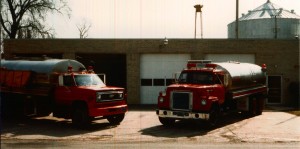Fire Chief discusses the need for EMTs in the Clinton community
It’s a cold day in January and an elderly couple just finished shoveling six inches of wet heavy snow. Once inside the house, the husband sits down and says “I’m not feeling well, my chest hurts and I have numbness in my left arm”
His wife knows he is having a heart attack and picks up the phone to dial 911 and get help from the local ambulance. The phone rings at the Rock County 911 Center and the dispatcher asks “911 what is you emergency?”
The elderly lady on the other end of the line says “my husband is having a heart attack.” The rest of the conversation between the elderly lady and the dispatcher is directed to help keep this lady’s husband alive until an ambulance arrives.
Almost immediately after the call is received at the 911 Center the tones go out for Clinton EMS to respond. After three sets of tones for Clinton EMS no one has answered the pager.
At this time the 911 dispatcher pages out the next available ambulance based on an Automatic Aid Agreement for the specific area of the call. There is still no response from Clinton EMS and another ambulance is responding from 15-20 minutes away. Without oxygen brain injury begins in less than five minutes so the outcome for this gentleman will probably be fatal. If you don’t think the above scenario could happen, think again.
Clinton EMS has been struggling for many years to keep well trained EMT’s on their staff. Today it is more difficult to find residents of the Fire Protection District willing to give up their free time to become EMT’s.
Even though there is no cost borne for the training, and they are compensated for their time, that still has not been enough. In the beginning of Clinton EMS the average EMT stayed with the service for about 10 years.
Today we have a turnover rate of 5 or less years, although there is a small core of “older lifers” that are holding on. You say “how can I help”; there are multiple ways that you can help Clinton EMS.
If you over 18 years of age and interested in becoming an EMT call or stop, and we will talk about the class and requirements. If you cannot be an EMT and you know someone that has shown interest in becoming an EMT please encourage them to stop out and talk to us. The future of Clinton EMS is uncertain and we are looking to the community to work with us on a solution.
WATER!!! I need more water!!! That’s the phrase no Fire Chief wants to hear from their interior firefighters. In the Village, while connected to a hydrant, that phrase is rarely heard.
In the rural areas that is not the case. Water for rural fires is carried in tenders (formerly called tankers) and when on scene they dumped their water into porta-tanks or what looks like a portable pool. These tenders carry anywhere from 2,000 to 4,000 gallons of water with each load.
Clinton Fire Department has had tenders since the ’40s. The chiefs prior to me were the forerunners in “super tankers” and put in our station two tankers that held 3,500 gallons each.
The surrounding fire departments soon followed with their own “super tankers” and this area is blessed with lots of water on wheels. The porta-tank will hold from 1,500 to 3,000 gallons of water and an engine drafts it out of the tank through the pump into the fire hose.
Today’s fire engines are capable of pumping from 1,250 to 1,500 gallons per minute. Its simple math that we need large volumes of water to feed the fire engines pump.
It’s not uncommon to use over 200,000 gallons on a rural fire. The majority of this water comes from the Village of Clinton through a hydrant but there are other ways to get water.
Firefighters are taught how to draft from local streams, creeks and ponds. This setup requires many more firefighters than when using the Village hydrant system. With today’s shortage of available firefighters we tend to use the hydrants to keep as many firefighters at the scene for extinguishing the fire.
Well if the looks of my lawn are any indication of what to expect for this fall’s wildland fire season we better start preparing. What special equipment do we use for wildland fires? How do we pay for this equipment and where do we get it from? That will be the discussion for next week.
Until next week, stay safe
Chief Rindfleisch
Courtesy photos
Clinton Fire Department has had tenders since the ’40s. The “super tankers” put in our station 3,500 gallons each.


